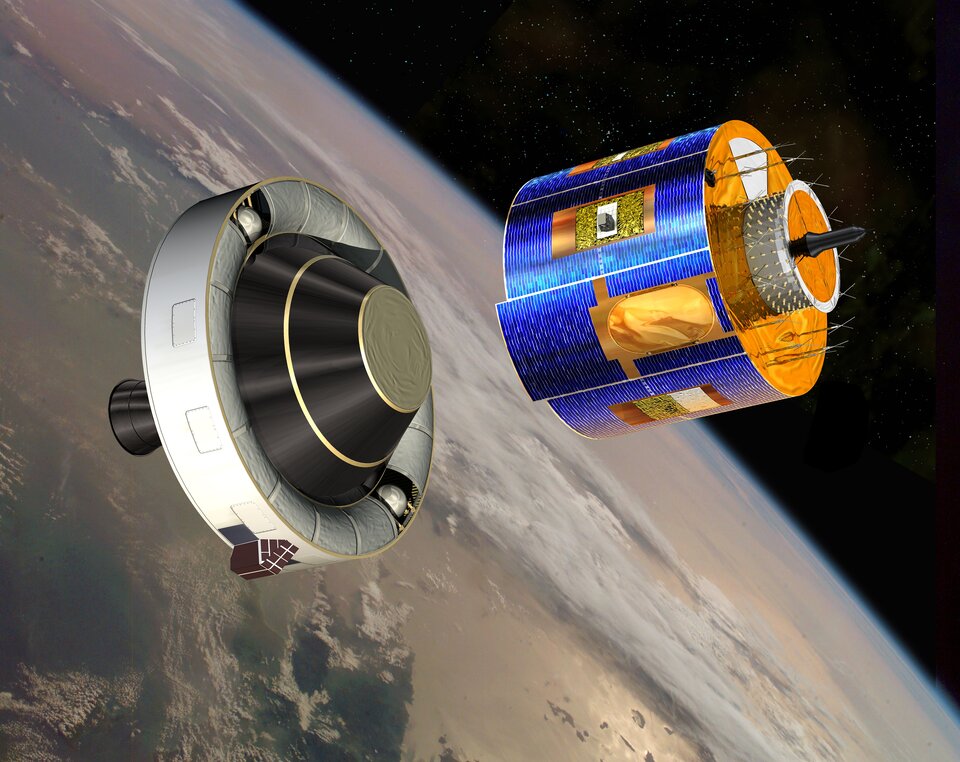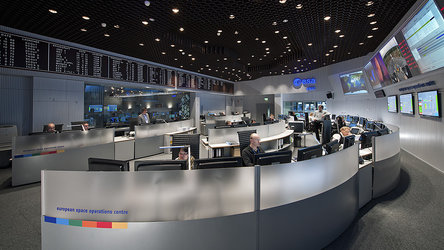ESA to provide essential launch control services to EUMETSAT
ESA and EUMETSAT, the European Organisation for the Exploitation of Meteorological Satellites, agreed today that ESA will provide essential launch control services for the last two Meteosat Second Generation (MSG) satellites, MSG-3 and MSG-4.
Under the agreement, ESA will provide control services during the critical launch and early orbit phase (LEOP), which involves moving the satellite from its initial position after separation from the launcher to its final orbit position 36,000 kilometres above the Earth.
Services will be provided from ESA's European Space Operations Centre (ESOC), in Darmstadt, Germany, the central establishment for the Agency's spacecraft operations activities.
The new agreement was signed today by the Director General of EUMETSAT, Dr Lars Prahm, and ESA's Director of Operations and Infrastructure, Gaele Winters. The contract, valued at over €4 million, also includes set up of related LEOP ground segment infrastructure at ESOC.

"The contract awarded today to ESA's space operations centre reflects the excellent long-term relationship between us and EUMETSAT. ESA will provide first-class service for the critical early phase in the lives of Europe's meteorological satellites based on 40 years of expertise," said Gaele Winters.
Dr Prahm stated that, "I am very happy to be signing this contract for the MSG-3 and 4 Launches and Early Orbit Phase following the very successful LEOP services provided by ESOC for MSG-1 and MSG-2."
ESOC: Europe's centre of operations excellence
ESOC flight control teams currently operate ten missions comprising 13 spacecraft, with ten more in active preparation.

ESOC has established a reputation as a centre of excellence for LEOP expertise, and has been awarded contracts by EUMETSAT for similar MSG launch services in the past.
MSG-3 and MSG-4 are scheduled for launch in January 2011 and January 2013, respectively.
Joint ESOC and EUMETSAT preparation for the launch of these satellites will begin around two years before the planned launch dates, which are not definite as they depend on the in-orbit status of the satellites and their missions.
Meteosat benefits European weather forecasting
ESA and EUMETSAT have a long-standing co-operation for the development and production of operational meteorological satellite missions.

Following the success of the first-generation Meteosats starting in 1977, the second generation of much-improved geostationary weather satellites (called Meteosat Second Generation – MSG) guarantees operational services until 2018.
MSG satellites serve Europe's forecasting needs – especially in the area of very short-time forecasts relevant in situations of severe weather as well as in numerical weather prediction models. The data are also important for climate monitoring. The image data generated by its 12 spectral channels provide 20 times the information of previous-generation satellites.
The first MSG satellite, which was renamed Meteosat-8, was launched in August 2002 and went operational in January 2004. The second MSG was launched in December 2005 and was renamed Meteosat-9.
EUMETSAT presently operates Meteosat-8 and -9 over Europe and Africa, and Meteosat-6 and -7 over the Indian Ocean.
Meteosat Second Generation is a joint project between ESA and EUMETSAT, based in Darmstadt, Germany.
ESA developed and procured the first two satellites, MSG-1 and MSG-2, and is procuring MSG-3 and MSG-4 on behalf of EUMETSAT, which developed the ground segment. EUMETSAT is also procuring the launchers, establishing user needs and running the MSG system.
EUMETSAT contributed one-third of the cost of the MSG-1 satellite and is paying for MSG-2, MSG-3 and MSG-4 in full. ESA contributed the remaining two-thirds of the cost of MSG-1 through an optional programme in which 13 of the Agency's Member States participate.















 Germany
Germany
 Austria
Austria
 Belgium
Belgium
 Denmark
Denmark
 Spain
Spain
 Estonia
Estonia
 Finland
Finland
 France
France
 Greece
Greece
 Hungary
Hungary
 Ireland
Ireland
 Italy
Italy
 Luxembourg
Luxembourg
 Norway
Norway
 The Netherlands
The Netherlands
 Poland
Poland
 Portugal
Portugal
 Czechia
Czechia
 Romania
Romania
 United Kingdom
United Kingdom
 Slovenia
Slovenia
 Sweden
Sweden
 Switzerland
Switzerland

































